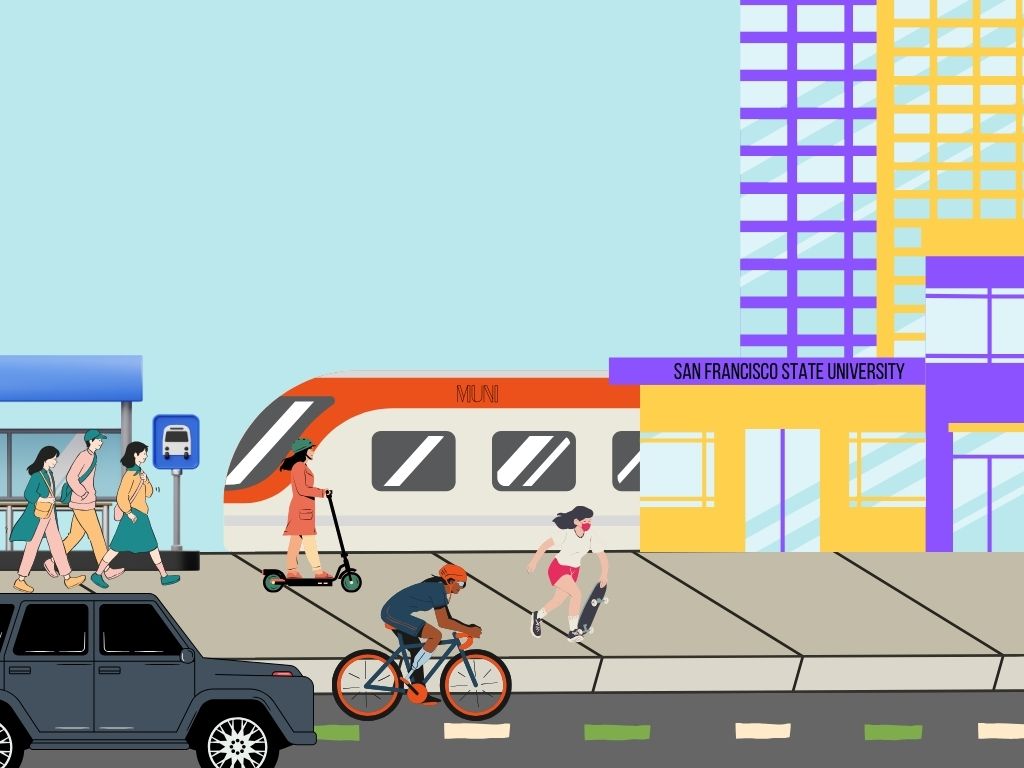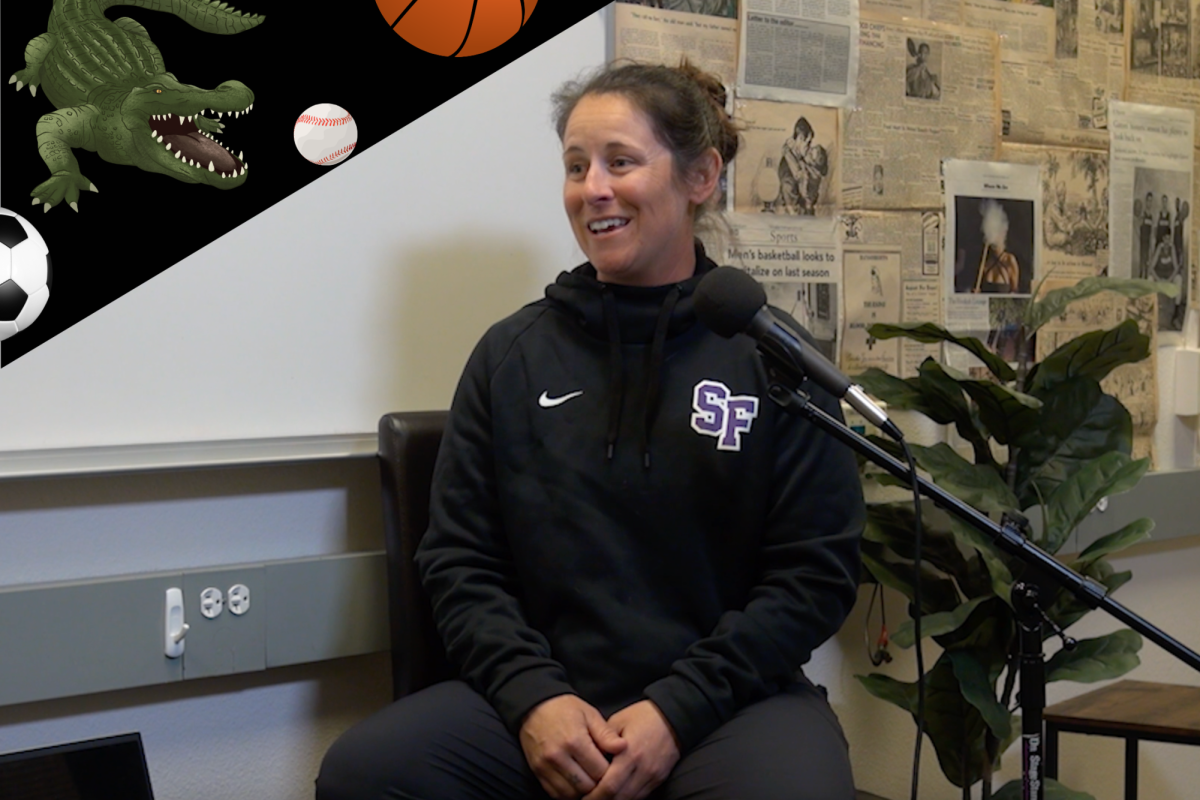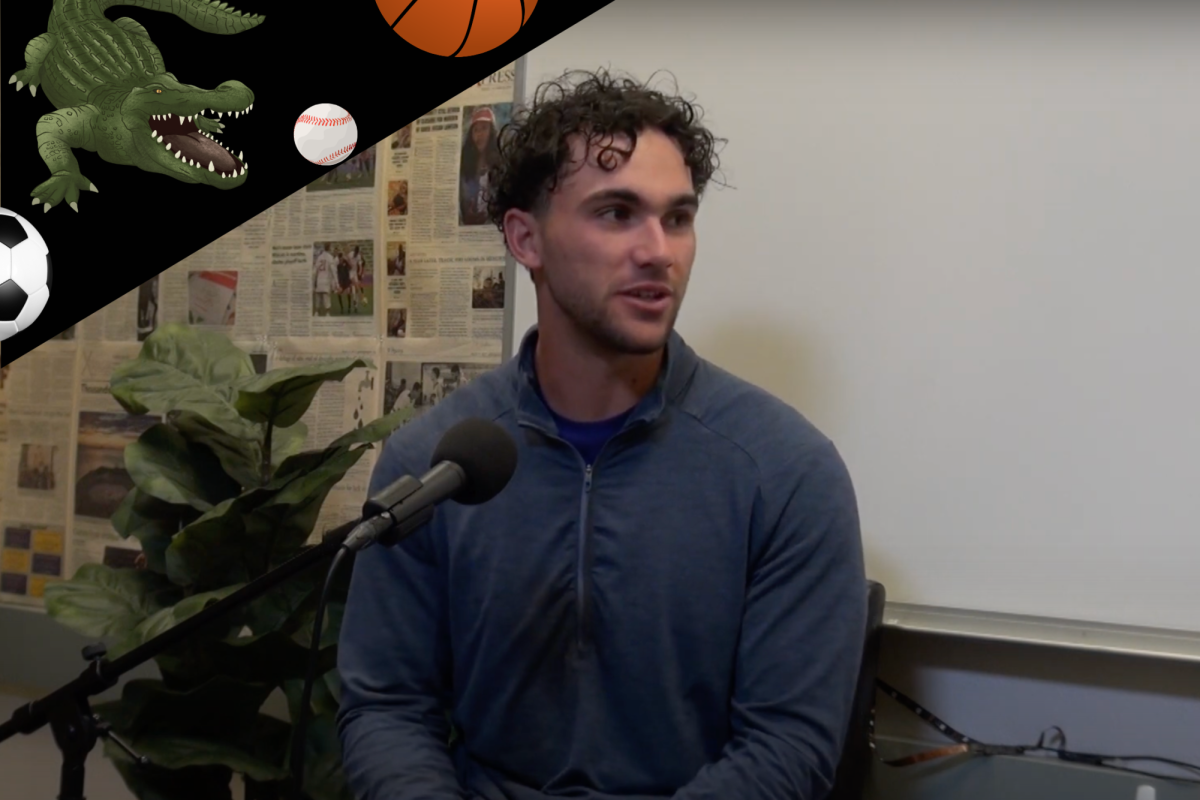San Francisco State University is known to be a commuter school, but where do students commute from?
Most commuter students live in the Bay Area, but a percentage of students live as far as Monterey, Modesto and Sacramento.
From Monday through Thursday, Roselie Roman wakes up at 4 a.m. and leaves her home by 4:30 a.m. to get ahead of the morning traffic on her commute to school from Citrus Heights, a city 15 miles from Sacramento. After driving over 100 miles, Roman arrives at school around 7 a.m. and works on her assignments while she waits for her 9:30 a.m. class to begin.
Her day does not finish with her last class at 3:30 p.m. because she still has to drive back home. After nearly three hours of driving over bridges, through traffic and greenery, Roman gets home around 6 p.m. to tend to her kids waiting for her. Unfortunately, she doesn’t leave campus until 6:30 p.m. on Tuesdays, causing even more exhaustion.
“If I don’t push myself past getting up and getting stuff done, getting to my lectures, listening to my professor, talking with my classmates, then I’m not chipping away at the bigger picture, which is getting that degree to get the job that’s going to help me have more of a sense of security and pay me back for this time that I’m sacrificing right now,” Roman said.
Roman, a mother of four, commutes over 200 miles for about five hours per day. She lives in a two-bedroom apartment with her daughter, three sons, a grandchild and her son’s partner. Given the lack of space, Roman is forced to sleep in her living room with her youngest child, 15, and her daughter, 18.
Raised in the Mission District, Roman felt it was part of her destiny to return to San Francisco to get her education. She originally went to San Diego State University from 2017-2019 to study rhetoric writing. In 2020, she left for Maui to be with her mother and sold cars.
During the height of the pandemic, Roman stayed in Florida for six months to nurture her grandfather who suffered a stroke. She took some time off and returned to the Golden State in 2021 and restarted her education journey at SFSU in the Fall 2022.
“I’m trying to give them the best example,” Roman said.
She aims to pursue a bachelor’s degree in English to become an educational writer and/or work in public policy. She hopes that earning a degree will help her financially support her family and demonstrate to her children that education can lead to long-term success.
Her commute to SFSU takes about one and a half to two hours. She passes through Vacaville and Vallejo and then onward to Oakland, where she crosses the Bay Bridge to enter San Francisco. During her drive, Roman listens to audiobooks or jazz in an attempt to zone out and pass the time.
To accommodate her drive, Roman purchased a brand new 2023 Chevy TrailBlazer and a gas club membership, including discounted groceries and hot and ready food items.
Roman chose SFSU over closer universities such as Sacramento State University because the school offered rhetoric writing, which is what she wanted for her English degree. CSUS now offers rhetoric writing courses, yet if given the chance to choose again, Roman would still pick SFSU.
During her 14 hours away from home, Roman frequently wishes she could spend that crucial time with her family.
“I’ve had days where I’m ready to be with my family,” Roman said. “I would like to talk with my family about their day, sit at the dinner table, and eat together. I enjoy the time that I can for myself, but I also miss the time that I can have with my family. It’s a paradox.”
On Tuesdays and Thursdays, Roman works part-time at the SFSU Early Childhood Education Center. Working part-time and being a full-time student has limited the number of hours she can work, which reduces Roman’s income.
“I’m not working full time; I’m making a sacrifice in working part-time,” Roman said. “It has brought my income down but that’s so that I can get the education that qualifies me for a higher paying job so I can better contribute and take better care of my family.”
Despite this challenge, she continues to drive miles and miles, crossing bridge after bridge, to secure a job with an income that can support all her family’s needs. Her family and mother support each other, which helps Roman focus on school when she needs to.
Roman’s commute from Citrus Heights requires a lot of dedication, considering the amount of time and money that is spent four days a week. Similarly to Roman, Armenia Diaz finds herself in the same position.
While Diaz also commutes to SFSU from the Sacramento area, her reasons differ from Roman’s. Roman chose SFSU for a specific educational field, whereas Diaz’s decision was based on financial considerations.
After graduating high school in 2010, Diaz wasn’t sure what to do with her life. She attended community college for two years before joining the Marines in May 2012. As her service was nearing its end five years later, Diaz decided to return to school in the fall of 2017.
During this time, Diaz consumed media that primarily focused on immigrants and deportation. She recalled watching a video of kids who could not speak English, which ignited her desire to become an interpreter and give kids a voice. She earned her interpreter certificate at Evergreen Valley College in San Jose.
However, after she started interpreting, she realized that her role was only translating, and she couldn’t advocate for anyone.
“You’re put in a position where you cannot advocate for who you’re interpreting for. You’re just there to say what everyone is saying,” Diaz said. “You’re just there as a bystander. Especially when you see people on the other end, speaking English, kind of talking down to them and getting mad or frustrated with them and you can’t be like, ‘Yo, calm down.'”
She then returned to school at San Jose City College and earned two associate’s degrees — in liberal arts and communication studies — in 2021. Originally, Diaz had planned to transfer to a different school, but the pandemic paused her transition and educational journey.
Due to their limited finances and growing living expenses, Diaz and her family decided to move to Sacramento, where it was easier to make ends meet. In 2023, Diaz stated that she couldn’t postpone her educational journey any longer and decided to return to school for the spring 2024 semester.
While making her decision, Diaz analyzed both financial aid packages from SFSU and CSUS. Diaz did not want to work and study simultaneously, so she attended SFSU, which offered more financial aid. Since San Francisco’s average rent is higher than Sacramento’s, the veteran’s benefits for SFSU were nearly double that of CSUS.
“Whenever I compare what I would be making here [Sacramento], it wouldn’t be enough: It is better to commute than lose that,” Diaz said. “It allows me to catch up on bills that I haven’t paid and gives me a little extra control, so I’d rather make that sacrifice to go out there.”
The higher GI Bill benefits provide Diaz with some stability in her household. However, unlike Roman, she does not have access to a car, which limits her commute options.
Being her first semester back at school in three years, it was difficult for Diaz to find a routine to make it to her 9:30 a.m. class on Mondays and Wednesdays.
“Those first couple of weeks of going to school were the most hectic,” Diaz said.
To save herself some time and money, she starts her morning at 4 a.m. and leaves by 5 a.m. to take a Flixbus trip to arrive in San Francisco by 7:30 a.m. If she were to take the train, which is a $70 round trip, she would have to leave at 6 a.m. to get to San Francisco by 9 a.m.
On Tuesdays and Thursdays, her classes begin at 12:30 p.m., giving her more time to sleep and ensure everything is organized before departing to school.
“I need to make sure that there’s breakfast on the table for the kids to eat later and that my dad could eat while I’m gone,” Diaz said.
For Diaz, the most difficult part of commuting is leaving her 9-year-old daughter and her infant son. She tends to ensure that her family is cared for before she can begin focusing on school. When she arrives home around 6:30-7:30 p.m., she feels depleted of her energy, but all her family wants is her attention.
“It makes me feel exhausted and stretched out because it feels like I come home and then my kids want my attention, then my husband wants attention and then trying to make sure my dad’s getting some attention,” Diaz said. “That’s exhausting.”
Diaz is not considering relocating closer to campus because it is too costly. Many SFSU students also face this difficulty, hence why the university has been trying to accommodate them by building affordable student housing.
SFSU has built extra dorms, most recently with Manzanita Square and the new West Campus Green project, which is projected to be open for students in Fall 2024. Given the university’s decline over the past few years, this is also an attempt to increase student enrollment.
To address the problem, the Strategic Enrollment Advisory Committee, created by SFSU President Lynn Mahoney, developed a Strategic Enrollment Management Plan that began in 2022 and will conclude in 2027. This plan hopes to find strategic ways to increase student enrollment in the coming years.
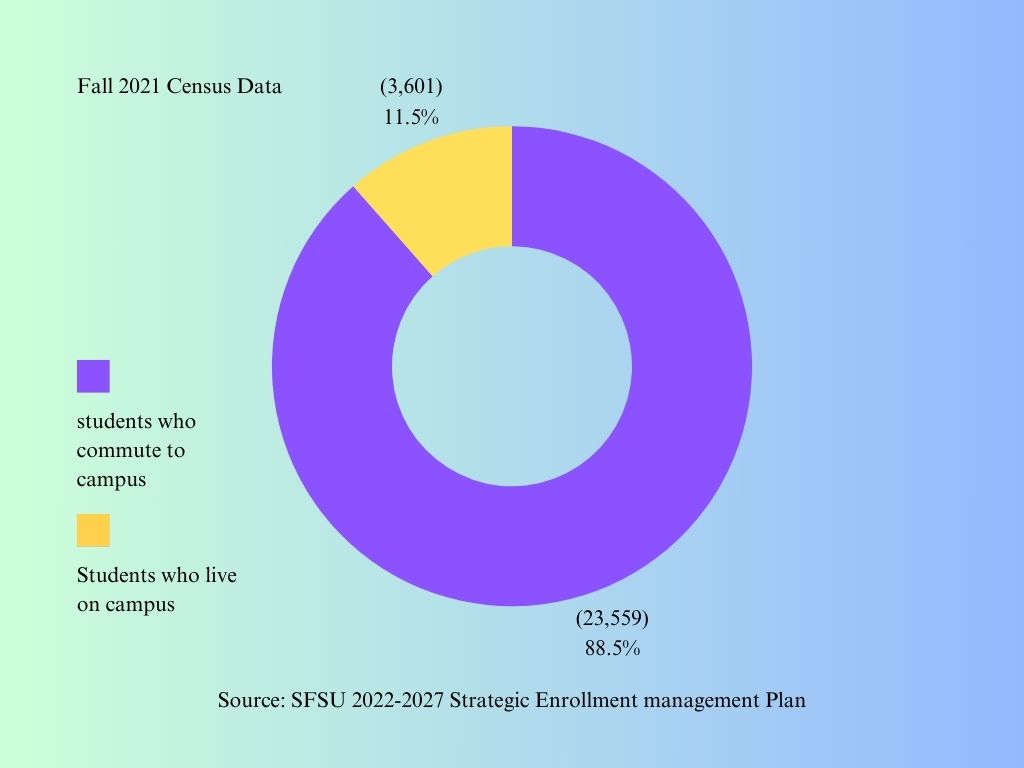
According to the document, “Of the 26,620, 11.5% of our students are residential and 88.5% are commuters, according to Fall 2021 census data.”
That number would equal 23,559 students who commuted to campus in Fall 2021.
Similarly, in a 2023 transportation survey conducted by SFSU’s Parking and Transportation Services and the Office of Sustainability, of 2,903 responses, 2,682 people said they live off campus. This survey gathered data from undergraduates, graduates, faculty, staff, and administration using their zip codes as a way to map where they come from. People living off campus live across 22 counties in Northern California.
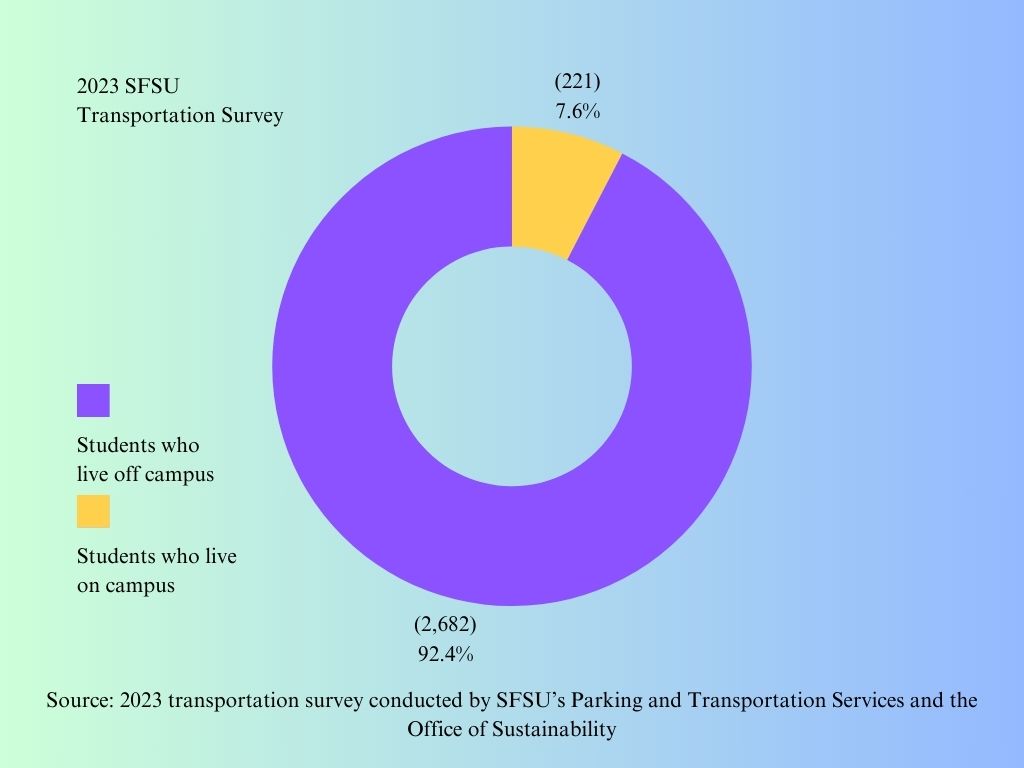
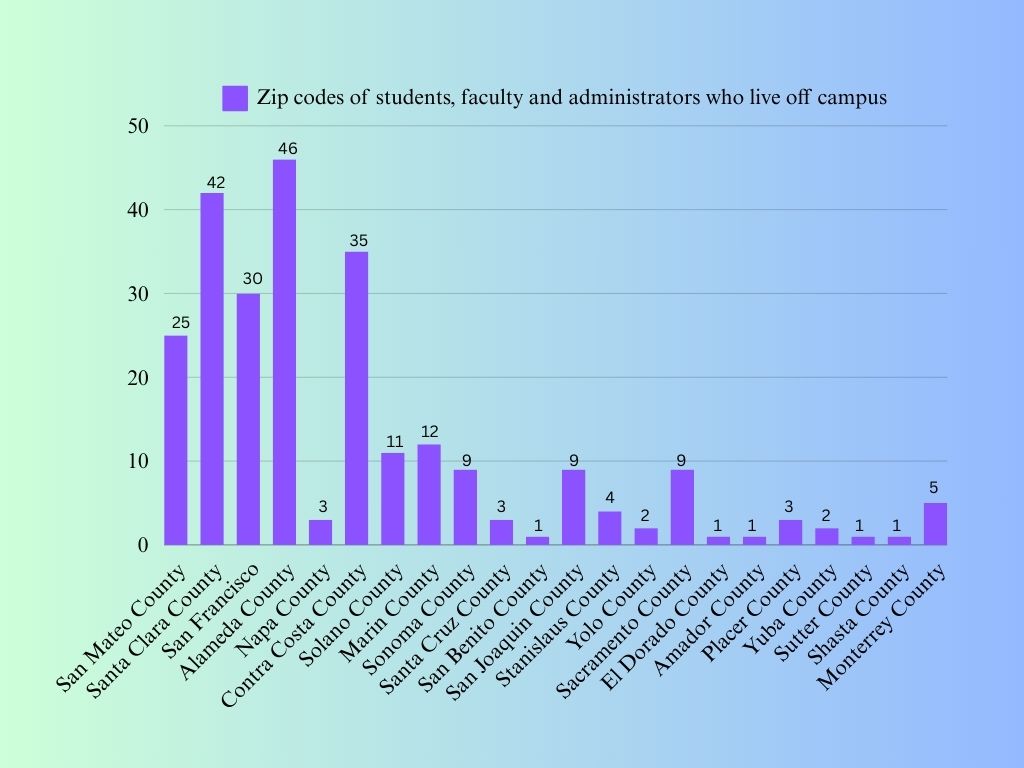
The survey asked how people commute to SFSU, and they responded by driving, walking, Muni, BART, Caltrain, SamTrans, AC Transit, Golden Gate Transit, motorcycle, e-scooter and taxi.
This information highlights where these people are commuting from and tells us that it’s not just students who have to make the trip to SFSU.
Ivan Ornelas is a lecturer who teaches Ethnic Studies and communications and works in the Metro College Success Program, an organization for first and second-year low-income or first-generation students.
Ornelas completed his graduate program at SFSU from 2017 to 2019 and has been teaching at the university since Fall 2021. Since then, he has been commuting from Livermore.
He teaches at SFSU on Tuesdays and Thursdays, starting at 12:30 p.m., which allows him to take BART. He also teaches communication classes at the College of Marin, where he’ll drive, considering it extends his commute and BART does not go towards Marin.
Regardless of when his classes begin, Ornelas chooses to get to campus around 9 a.m. to get his day started early and avoid potential BART delays.
“The biggest thing is that you’re relying on factors that are out of your control,” Ornelas said. “You can’t control traffic, you can’t control BART delays. Best thing you can do is just give yourself that buffer and that’s why I set my schedule the best I can, so I’m never in a position where I’m going to be late to class.”
Ornelas lives near the Dublin/Pleasanton BART station, making it very accessible to him. His commute to SFSU takes about an hour. If he were to drive, it would take about an hour and 20 minutes, along with the payment of bridge toll, parking and gas.
Despite being confident in his ability to manage the commute, some people, including his brother, are skeptical.
“While there are people that expressed some concerns with the commute I do reaffirm them that I can handle it,” Ornelas said. “I very rarely am late, but actions speak louder than words and to be someone that you are dedicating yourself to this position and commuting, you have to be somewhat disciplined.”
Ornelas’ wife has been his biggest support, according to him. She teaches special education classes at a preschool and kindergarten in Pleasanton. When he arrives home, he makes sure to find a balance between school and enjoying her company.
Often in his classes, Ornelas attempts to build connections with his students so they can have good student-teacher relationships. As a result, some students have opened up about the financial situations that have prevented them from going to class.
“I’ve had students tell me that they’ve missed class because they couldn’t afford BART,” Ornelas said. “It’s not just a commute problem — it’s also like they’re stretching out whatever money they have for other expenses too.”
Ornelas has referred students to SFSU’s GatorHealth and Well-being to assist them with transportation and finding nearby housing.
One solution Ornelas has to solve this issue for students is to add more online classes. He believes the pandemic showed us that students can learn online, but since the university has shifted back to in-person learning, online classes have been slowly diminishing.
To deal with the issue, SFSU has been offering Gator Passes. The Gator Pass provides students unlimited rides for Muni Metro trains and buses while offering a 50% discount on all BART rides to and from Daly City station.
Recently, SFSU’s Associated Students pitched a proposed change to the Gator Pass that would offer unlimited Muni and BART and other transit agencies such as Caltrain, SamTrans, and Golden Gate Transit. The change would also adjust the price of the Gator Pass to $130 per semester.
This would be a delight for all commuting students. For Diana Martinez, it would save her almost $10 for a round trip to campus from Richmond.
Martinez is in her second year at SFSU and pursuing a degree in psychology. When she began her freshman year, Martinez wasn’t ready to move out of her parent’s home, saying it was a better financial decision to stay at home.
However, one of the issues commuting students face is they’re not able to make connections with students as easily as others who live on campus.
“My first year was a little hard just because everyone else around me was rooming together,” Martinez said. “I feel like it took me a while to kind of make friends just because I couldn’t be here all the time and hang out with people outside of class.”
For commuting students, finding a balance between school, work, making friends and spending time with family is difficult. Luckily, Martinez was able to find friends who live in San Francisco, making her experience much easier.
Her commute begins at 8 a.m. in Richmond, lasting about an hour and 20 minutes. On Mondays and Wednesdays, she leaves school at 1:45 p.m. and arrives home at 3:30 p.m., whereas on Tuesdays and Thursdays, she’s able to get home around 1:40 p.m.
In some cases, Martinez can leave campus as soon as she arrives.
“It’s happened to me so many times where I’ve done the commute, I got to campus and then I get an email saying classes are canceled and it’s just like, I just paid parking [at the BART station], I came here an hour and a half early, just for class to be canceled,” Martinez said. “It’s just annoying having to leave so early when I know that other people on campus can just leave like 10 minutes before class starts.”
Although Martinez is sometimes tired and frustrated with her commute to SFSU, she attempts to find the silver lining and appreciates that she’s able to visit different places on BART that she wouldn’t see driving on the 580 freeway.
BART is used by many students to help them commute to their homes in San Francisco and across the East Bay. However, BART is sometimes not the safest form of transportation.
As Martinez was sitting on BART scrolling through her phone earlier in the year, she felt someone staring at her. She looked up, scanned the area and ignored it. She felt something again, looked up, and saw a man staring back at her while touching himself.
A bystander called the police and proceeded to arrest the man.
“After that, I’ve been a little scared to take the BART,” Martinez said. “I wasn’t aware of my surroundings just because I’ve gotten comfortable with taking BART and I’ve never experienced anything like that.”
Despite this, Martinez still prefers to take BART because of what she would spend if she were to drive. Since then, Martinez’s family worries whenever she hops on BART and leaves her home to go to school.
However, Martinez can return to her home before most even finish their last class of the day.
Other students, such as Ericka Gonzales, usually don’t go home until late at night.
Gonzales is a third-year biochemistry major with an interest in DNA and mutations. She commutes from East Side San Jose, about an hour to an hour and 20 minutes away, depending on traffic.
During the semester, Gonzales was involved in a car accident, which caused her to avoid getting behind the wheel. She tried to take Caltrain and then Muni, but she got lost, which terrified her even more.
“I’ve never taken the Muni to SF before and I got dropped off in some weird downtown area. I called an Uber to pick me up and that cost like 20 bucks,” Gonzales said. “I ordered another Uber when I was done with school and that cost me 20 bucks. I took the Caltrain back to San Jose and I had to pay for parking to leave my car so I think I spent like 70 dollars. I was like, ‘Yeah, I’m not gonna do that every single day.'”
She commutes to school Monday through Friday, and depending on what she needs to accomplish, she’ll leave her home at 5 or 11 a.m. She stated that she doesn’t necessarily choose to leave so early but that her major requires an extensive amount of work and the resources are all on campus.
She’ll sometimes have to do research with an incubator, and if she leaves something in it for 16 hours, then she’ll come in at the time ready to be taken out, even if it is early in the morning. This will sometimes also cause her to stay on campus very late — as late as 2 a.m.
She also said she sometimes gets as few as three hours of sleep. If she has nothing to do the following day, she will sleep until 2 p.m. This sleep schedule, however, is not sustainable as it can impair her vision while driving.
“I have been scared of falling asleep on the wheel before because I have fallen asleep,” Gonzales said. “I was driving back home and there was one time when I was so close to the wall that split the lanes. My car has sensors so the beeping of the sensors woke me up.”
Gonzales feels drained after a long day at school but loves what she gets to do in her research. Her only regret, however, is that she isn’t able to see her family as much. She’ll leave the house before they wake up and arrive once everyone is asleep.
Despite this, Gonzales continues to push herself to be the best student she can be.
“I have no idea where I’m going to end up,” Gonzales said. “Me being held back a semester and not moving forward is not an option, so this has got to be worth it. I don’t have a backup plan. This is my plan.”
Commuting students make up the majority of the student population on campus. This population goes to school not necessarily because of the campus or city life but because they want to earn an education that will propel their careers to where they want to be.
Although constantly spending money is stressful, as is missing time with family and facing several safety concerns, walking across the stage at Oracle Park will validate all the hard work each student put in to earn their degrees.




